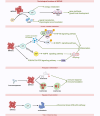IMPDH2's Central Role in Cellular Growth and Diseases: A Potential Therapeutic Target
- PMID: 40251939
- PMCID: PMC12179559
- DOI: 10.1111/cpr.70031
IMPDH2's Central Role in Cellular Growth and Diseases: A Potential Therapeutic Target
Abstract
IMPDH2 is a rate-limiting enzyme in guanine nucleotide biosynthesis. It plays diverse roles in various physiological and pathological processes: nucleotide metabolism, inflammation, immune function, ribosomal stress. Structural or regulatory alterations in IMPDH2 are linked to significant health issues, and critical relevance in disease progression. We aim to underscore the potential of IMPDH2 as a promising therapeutic target for clinical applications.
© 2025 The Author(s). Cell Proliferation published by Beijing Institute for Stem Cell and Regenerative Medicine and John Wiley & Sons Ltd.
Conflict of interest statement
The authors declare no conflicts of interest.
Figures



References
-
- Shah C. P., Purushothaman G., Thiruvenkatam V., Kirubakaran S., Juvale K., and Kharkar P. S., “Design, Synthesis and Biological Evaluation of Helicobacter Pylori Inosine 5′‐Monophosphate Dehydrogenase (HpIMPDH) Inhibitors. Further Optimization of Selectivity Towards HpIMPDH Over Human IMPDH2,” Bioorganic Chemistry 87 (2019): 753–764, 10.1016/j.bioorg.2019.04.001. - DOI - PubMed
-
- Glesne D., Collart F., Varkony T., Drabkin H., and Huberman E., “Chromosomal Localization and Structure of the Human Type II IMP Dehydrogenase Gene (IMPDH2),” Genomics 16, no. 1 (1993): 274–277. - PubMed
-
- Zhang R., Evans G., Rotella F. J., et al., “Characteristics and Crystal Structure of Bacterial Inosine‐5′‐Monophosphate Dehydrogenase,” Biochemistry 38, no. 15 (1999): 4691–4700. - PubMed
Publication types
MeSH terms
Substances
Grants and funding
LinkOut - more resources
Full Text Sources

